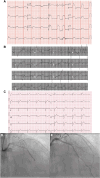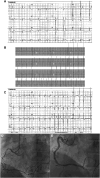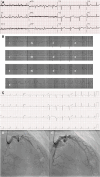Do electrocardiographic changes induced during intracoronary vasospasm provocation testing reflect those during spontaneous angina episodes in patients with vasospastic angina?: a case series
- PMID: 39161720
- PMCID: PMC11332263
- DOI: 10.1093/ehjcr/ytae386
Do electrocardiographic changes induced during intracoronary vasospasm provocation testing reflect those during spontaneous angina episodes in patients with vasospastic angina?: a case series
Abstract
Background: According to the Coronary Vasomotor Disorders International Study (COVADIS) group, the ECG criteria supporting the diagnosis of vasospastic angina (VSA) in spontaneous episodes or induced during intracoronary spasm testing are similar. However, it remains elusive whether acetylcholine-induced ECG changes during epicardial spasms reflect ECG changes that occur during the height of a spontaneous episode.
Case summary: We present four patients diagnosed with VSA during intracoronary spasm testing, of whom the ECG characteristics during spasm testing and a spontaneous angina episode are described. All patients have >90% coronary epicardial vasoconstriction in one or more vessels during acetylcholine provocation. ECGs at the height of a spontaneous episode and during acetylcholine-induced coronary spasm are found to be different in three out of four patients.
Discussion: In patients with VSA, the ECG at the height of a spontaneous episode and during acetylcholine-induced coronary artery spasm may differ substantially. In patients with symptoms suspicious of VSA, every effort should be undertaken to obtain ECGs during the height of a spontaneous episode of angina pectoris and there should be a low threshold to perform intracoronary function testing.
Keywords: Case report; Electrocardiogram; Epicardial vasospasm; Intracoronary spasm testing; Vasomotor dysfunction; Vasospastic angina.
© The Author(s) 2024. Published by Oxford University Press on behalf of the European Society of Cardiology.
Conflict of interest statement
Conflict of interest: None declared.
Figures






Similar articles
-
Safety and potential usefulness of sequential intracoronary acetylcholine and ergonovine administration for spasm provocation testing.Ther Adv Cardiovasc Dis. 2024 Jan-Dec;18:17539447241233168. doi: 10.1177/17539447241233168. Ther Adv Cardiovasc Dis. 2024. PMID: 38396350 Free PMC article.
-
Invasive Evaluation for Coronary Vasospasm.US Cardiol. 2023 Jun 9;17:e07. doi: 10.15420/usc.2022.33. eCollection 2023. US Cardiol. 2023. PMID: 39493950 Free PMC article. Review.
-
Clinical usefulness, angiographic characteristics, and safety evaluation of intracoronary acetylcholine provocation testing among 921 consecutive white patients with unobstructed coronary arteries.Circulation. 2014 Apr 29;129(17):1723-30. doi: 10.1161/CIRCULATIONAHA.113.004096. Epub 2014 Feb 26. Circulation. 2014. PMID: 24573349 Clinical Trial.
-
Coronary vasomotor response to intracoronary acetylcholine injection, clinical features, and long-term prognosis in 873 consecutive patients with coronary spasm: analysis of a single-center study over 20 years.J Am Heart Assoc. 2013 Jul 15;2(4):e000227. doi: 10.1161/JAHA.113.000227. J Am Heart Assoc. 2013. PMID: 23858100 Free PMC article.
-
Vasospastic angina: a review on diagnostic approach and management.Ther Adv Cardiovasc Dis. 2024 Jan-Dec;18:17539447241230400. doi: 10.1177/17539447241230400. Ther Adv Cardiovasc Dis. 2024. PMID: 38343041 Free PMC article. Review.
References
-
- Knuuti J, Wijns W, Saraste A, Capodanno D, Barbato E, Funck-Brentano C, et al. . 2019 ESC guidelines for the diagnosis and management of chronic coronary syndromes. Eur Heart J 2020;41:407–477. - PubMed
-
- Reeh J, Therming CB, Heitmann M, Højberg S, Sørum C, Bech J, et al. . Prediction of obstructive coronary artery disease and prognosis in patients with suspected stable angina. Eur Heart J 2019;40:1426–1435. - PubMed
-
- Kunadian V, Chieffo A, Camici PG, Berry C, Escaned J, Maas AHEM, et al. . An EAPCI expert consensus document on ischaemia with non-obstructive coronary arteries in collaboration with European society of cardiology working group on coronary pathophysiology & microcirculation endorsed by coronary vasomotor disorders international study group. Eur Heart J 2020;41:3504–3520. - PMC - PubMed
-
- Virani SS, Newby LK, Arnold SV, Bittner V, Brewer LC, Demeter SH, et al. . 2023 AHA/ACC/ACCP/ASPC/NLA/PCNA guideline for the management of patients with chronic coronary disease: a report of the American Heart Association/American College of Cardiology Joint Committee on Clinical Practice Guidelines. Circ 2023;148:e9–e119. - PubMed
Publication types
LinkOut - more resources
Full Text Sources
